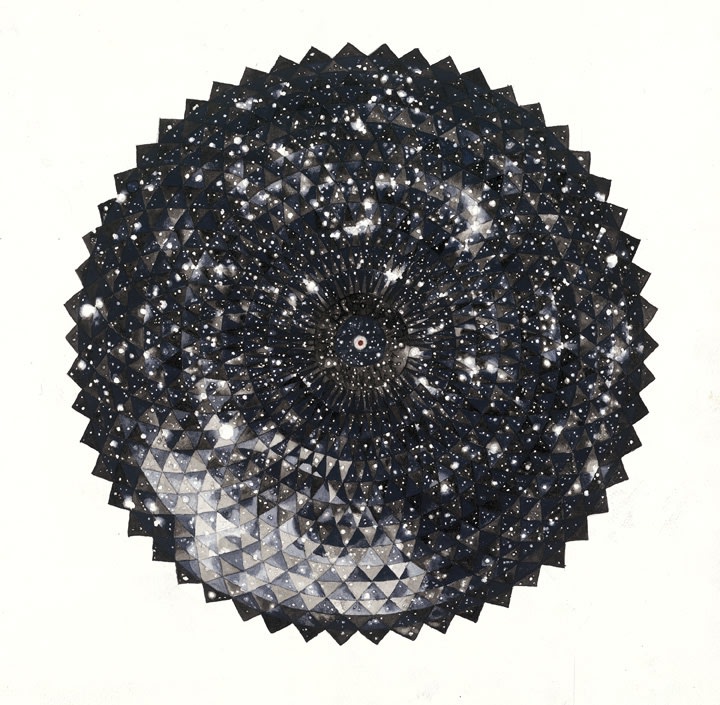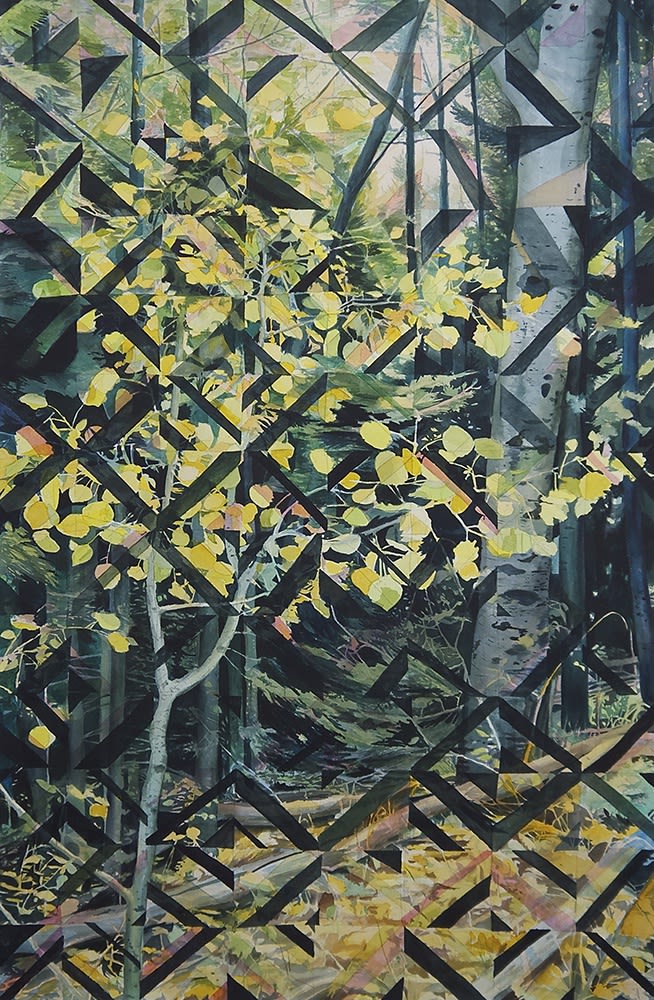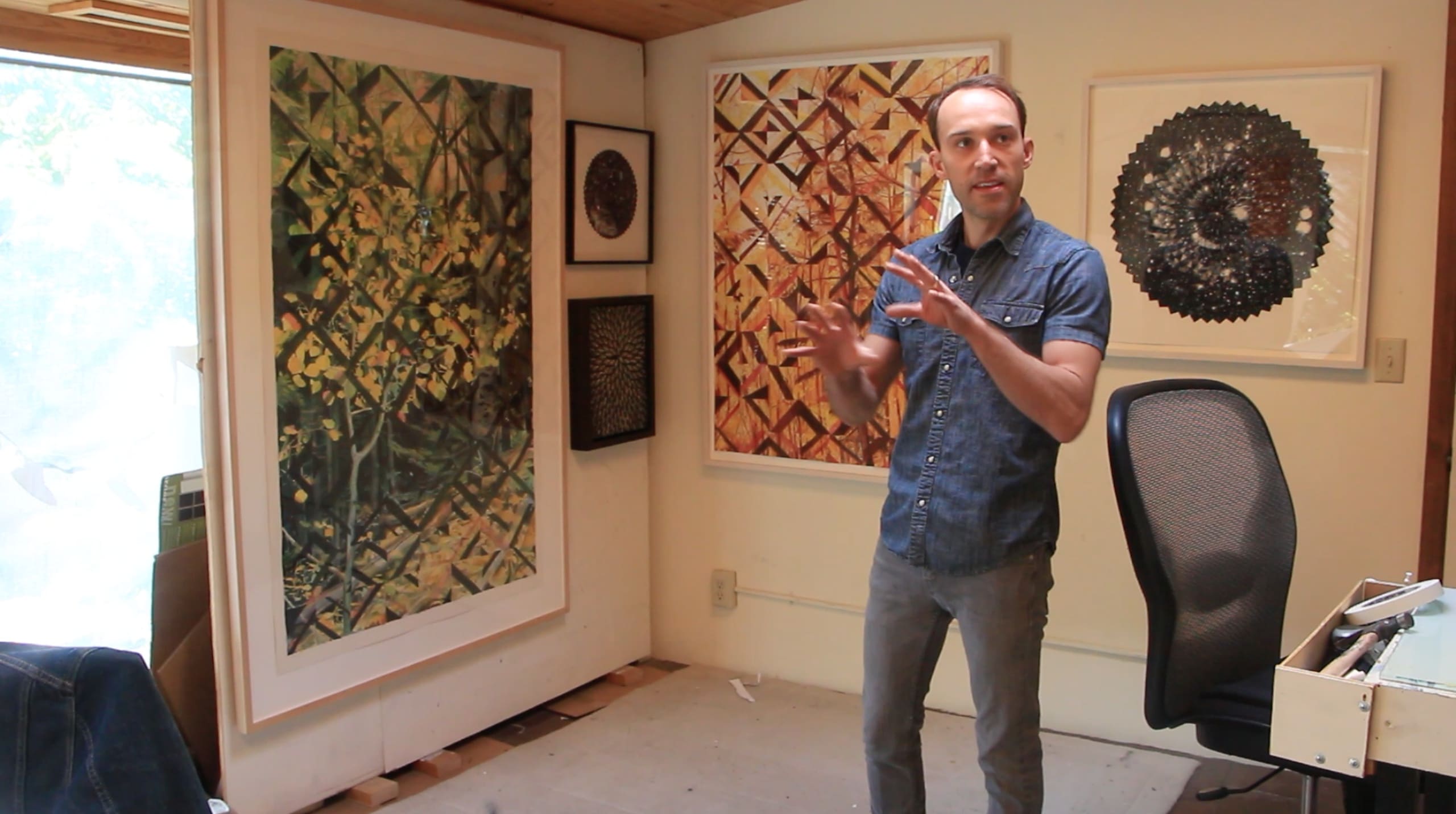
“When we moved here, I was so excited that I’d be working in a greenhouse,” says Matthew Mullins. “There’s so much light, and also the possibility of actually growing some things in here.” He’s tending to the small jungle that occupies one corner of his home studio, just off Canyon Road in Santa Fe. Surrounding the real greenery, there’s a series of mixed media paintings that echo the natural patterns of the plants. Matt starts by painting a landscape or natural detail in watercolor, and then overlays a human-made pattern—like a quilt or tile design—atop the natural scene using acrylic ink. Then he works back and forth, sharpening details in the scene or strengthening the pattern in a compositional push-and-pull. “I’m really focusing on the interconnection between humans and nature,” Matt explains. “The patterns, they’re kind of like our filters of how we’re interacting with nature. It’s a metaphor for the connections of humanity and nature.”
Matthew moved to Santa Fe in 2011 from Berkeley, California. He spent most of his childhood in the Bay Area, and attended Sonoma State University and the University of California, Berkeley. “When I was at UC Berkeley getting my MFA, I was around all these archives and labs and machinery,” he says. His fascination for hidden corners of the school’s research libraries inspired a series of photorealistic watercolors of stacked books, dusty typewriters and tangled scientific equipment. Now, he paints fragmented nature scenes and mandalas of the cosmos. In this Q & A, we spoke with Matthew about his transition to New Mexico, how the landscape has transformed his artwork, and his current inspiration.

When did you first start working with watercolors?
My first painting class was a watercolor class at a community college in the Bay Area. I loved it, and really connected with it right away. It was during a period where I wasn’t necessarily planning on being an artist. I was going to school to be a chiropractor, and taking a lot of science classes. The art class was really where my heart was. I took beginner’s and advanced watercolor classes, but when I went to Sonoma State I started painting with oil and acrylic. I didn’t really touch watercolor again until I got to grad school.
I started using watercolor again because […] I wanted to force myself into a really fluid medium, and practice being looser and painting the whole composition at once through layers rather than piece by piece. Once I started getting into that, it felt like that was the way to paint. I was able to get into these painting flows much better, rather than a really punctuated process of doing these little sections. With the watercolor I can just have my palette there, and the paint doesn’t really dry out the way that acrylic does. I can just be there for hours, painting and getting into this really great flow, which is why I paint.
Tell us about your progression from photorealistic watercolors to natural scenes with bold, abstract patterns.
That transition in style had a lot to do with what I was doing in my life, and where I was. The archives and more photorealist work, I was doing when I was in grad school in Berkeley. I think that kind of environment lead me to these places that are repositories for all of this information. It was all of these artifacts that kind of embody peoples’ work and knowledge, and the human body of knowledge growing.
Then when I moved to New Mexico, I was going outside all of the time, spending a lot of time in nature. I’ve always had an interest in science, and when you look at plants or stars, there’s these patterns and systems, and there’s this organization at every level—macro to micro. There’s some sort of organization and pattern. There’s also chaos, but there’s some sort of predictability or way that these things are being organized.

Matthew Mullins, Chicoma, acrylic ink and watercolor on paper
How did moving to New Mexico change the way you look at the world?
It was a big shock, with the amount of space. I think one of the bigger surprises was how far you could see, and how crisp everything is when you see it far away. In Berkeley when you’re looking over the water, which is pretty much the only place where you could have a far vista, everything gets really diffuse pretty quickly from all the fog in the atmosphere. All the colors get muted and turn gray. Here it’s crisp 40 miles away, a real vista. My palette got much more vivid after moving here.
Did you start painting the landscape right away?
At first, I was resistant to change. Being aware of the art history in Santa Fe and predominant styles around here, I didn’t want to paint landscapes. I wanted to avoid all of my preconceived notions of what I thought art in Santa Fe was. So I was pretty stubborn at first, like, “I’m going to paint these archives and these machines. This is what I do. I’m not going to really be influenced by what’s around me.” Then I couldn’t help being influenced by what’s around me.
My initial watercolor studies [of the New Mexico landscape] were monochromatic. I was painting monochromatically because I was really teaching myself how to paint the landscape. I had never really painted landscapes that seriously before. I was painting a lot of machinery and human-made things before. With all of the edges and the way the light works, it’s much harder to paint the landscape. The monochrome made it easier because I was only working with value and form rather than color relationships as well. Once I dialed that in a little bit better, then I started incorporating color. I love color and I want to use a lot of it, so the monochromatic stuff was just practice.

When you discuss your influences, you often reference photographers as well as painters. How does photography influence your work?
I look at a lot of photography, and there’s a lot of photographers that I really like. Andreas Gursky is a big influence, for all of the detailed information that’s in those photos. All of my paintings start from photography, but they’re my own shots. I treat it mostly as a tool to get to the painting and to be able to record nature and bring it back into the studio. It’s the first step to kick the painting off, kind of like a sketchbook.
It usually starts with light or something that just catches my eye. Then I might get my camera out, and from the camera lens I’ll start composing. I don’t really compose in my mind that much. I just go after what catches my eye and then look a little closer.

Matthew Mullins, The Creation of Iron, watercolor and blood on paper.
In your mandala series, The Creation of the Elements, you incorporate unconventional materials into the works, like a drop of blood or a bit of copper. Tell us about the conceptual reasoning behind that.
With the blood, it was a surprise. I wasn’t planning that until the very end. I started that painting working from the outside in. I was like, ‘How is this going to resolve?’ When I was getting close to the middle, I was thinking that stars are where all of the elements are created except for hydrogen. Everything more complicated than hydrogen is created inside of a star. I was thinking that the iron, copper and the elements in my body are actually made in stars. I wanted a human connection to that.
In your works that blend human-made patterns with natural scenes, you use watercolor and acrylic ink. What are some differences between handling those two mediums?
The acrylic ink is much riskier than the watercolor. The second it goes on, it stains and you can’t really get it off. With watercolor, you can kind of loosen it up and dab it out and lighten it. It still stains the paper a little bit, but not like acrylic ink. With the ink, every little waver of your hand is recorded. I like how it records that detail, and it makes it waterproof so when you go over it with the next layers it doesn’t smudge or soften up.
I just try to get into a flow. I don’t focus too much on making the lines perfect, I just try not to second guess myself. Once I start slowing down, I start editing too much. The paintings are really structural and I could get bogged down in all the details, but I want to not be too strict on myself and just roll with the process.
What are you working on next?
I feel like I’m just getting started [with these series]. There’s three different avenues to go down with this work. I’m just pushing the snowball down the hill, and I feel like everything I’m doing can take on a lot more. The deadline of this show, and the excitement of getting my work out of the studio has lit a fire under me.